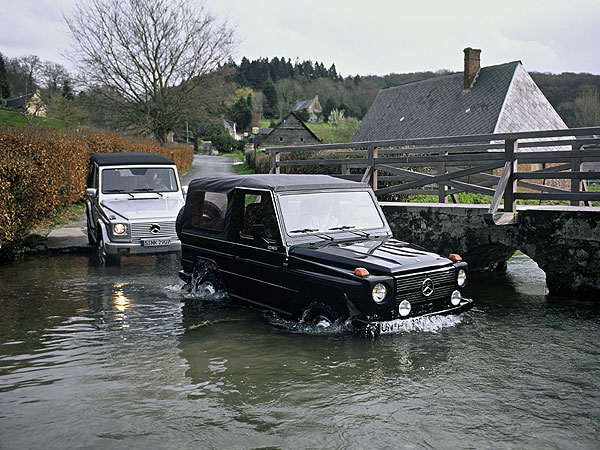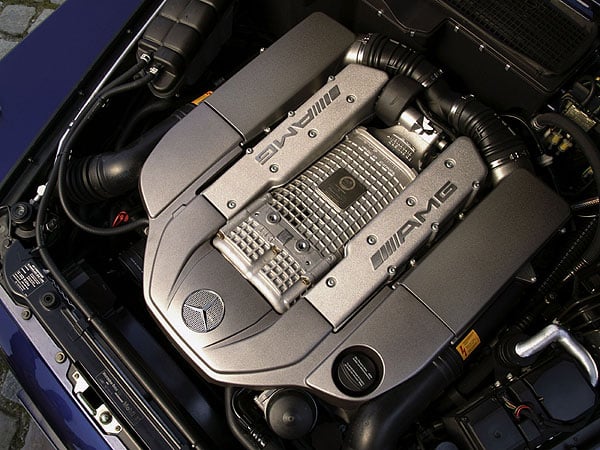
It is now 25 years since production began of the Mercedes-Benz G-Class. The Stuttgart-based car maker unveiled the robust Cross-Country Vehicle to the public for the first time in 1979, since when it has delivered a total of some 175,000 units of the G-Class to customers the world over. Its striking appearance – unchanged throughout its 25-year lifespan – and outstanding engineering has secured the Mercedes Cross-Country Vehicle cult status in the automotive world and earned it a reputation as one of the most coveted classics on the market. Mushrooming demand in the USA saw G-Class sales skyrocket in 2002 and 2003.

A policy of continuous renewal has allowed the G-Class to keep pace with advances in technology to the point where the Mercedes classic can now be ordered with the most powerful drive system in the brand’s product range. With a combination of permanent four-wheel drive and the electronically controlled traction system 4ETS, ESP®, the Low Range gear ratio and three manually selectable differential locks, the G-Class is the master of all it surveys off the beaten track whilst at the same time offering the driving safety you would expect of a Mercedes-Benz on the road. The new G 55 AMG is standing by to round off the model range from the middle of 2004, its eight-cylinder supercharged engine developing 350 kW/476 hp and a maximum torque of 700 Newton metres.
The development programme for a new cross-country vehicle was launched in 1972 with a cooperation agreement between Daimler-Benz and the Steyr-Daimler-Puch company based in the Austrian city of Graz. Series production was given the green light in 1975, as was the construction of a new plant in Graz, where the G-Class is still built today – and still predominantly by hand. Market launch in the spring of 1979 saw the new off-road expert available with a choice of four engine variants – with outputs ranging from 53 kW/72 hp to 110 kW/150 hp – and in either Cabriolet, short-wheelbase Station Wagon or long-wheelbase Station Wagon guise. Today, the G-Class range spans five models, including three powerful eight-cylinder variants.


Flawless off-road ability anchored in robust engineering
From the outset, the G-Class has been designed to take on and conquer even the most challenging terrain. Providing the formidable basis for the Mercedes-Benz Cross-Country Vehicle is a frame consisting of closed longitudinal profiles and cross members, which ensures exceptional bending and torsional stiffness. The frame supports robust rigid axles with large coil springs and long spring travel, technology which comes into its own off road. Sufficient climbing ability to put grades of up to 80 percent within range, a maximum tilt angle of 54 percent, 21-centimetre ground clearance and impressive angles of approach (36 degrees) and departure (27 degrees) equip the G-Class to negotiate the trickiest off-road terrain with majestic ease. At the same time, the chassis also provides safe and comfortable handling on smooth tarmac.
As the G-Class celebrates the 25th anniversary of its entry into production, the proven technical concept underpinning the off-road Mercedes remains untouched. What the engineers have done is constantly upgrade the technology and equipment features of the Cross-Country Vehicle since its introduction in 1979. An automatic transmission and air conditioning system were made available back in 1981, for example, and the G-Class has been fitted with permanent four-wheel drive, differential locks on the front and rear axles and a fully locking central differential as standard since 1990. ESP®, 4ETS and Brake Assist were added in 2001, allowing the off-roader to offer a combination of high-performance traction and driving safety systems unmatched in the automotive world.


New G 55 AMG with 350-kW/476-hp supercharged V8 engine
Marking its arrival at the summit of the engine range in mid-2004 will be the new G 55 AMG. Its V8 power unit develops 350 kW/476 hp and puts a maximum torque of 700 Newton metres on tap from 2650 rpm. These performance credentials enable the G 55 AMG to outstrip its naturally aspirated V8 predecessor model by 34 percent in the output stakes and by 32 percent in terms of torque. In other words, the new G 55 AMG can call on generous reserves of power both on the road and over loose terrain, generating unparalleled authority, exclusiveness and driving dynamics. Indeed, its performance figures may well draw some envious glances from the sports car market, the G-Class accelerating from 0 to 100 km/h in just 5.6 seconds on its way to a maximum speed of 210 km/h.
Text/Photos: DaimlerChrysler






